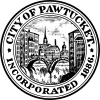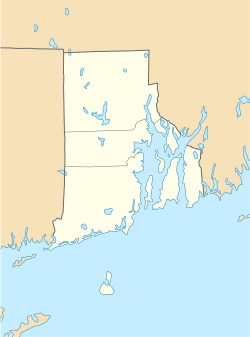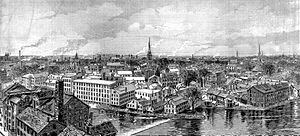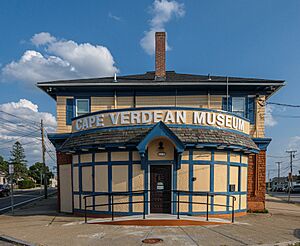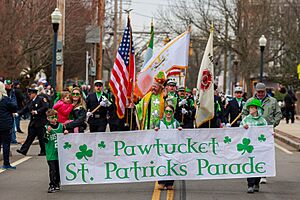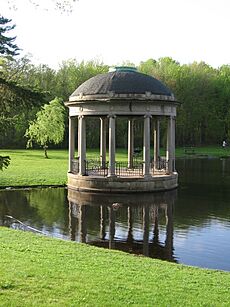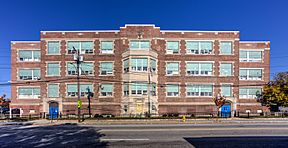Pawtucket, Rhode Island facts for kids
Quick facts for kids
Pawtucket
|
|||||
|---|---|---|---|---|---|
|
City
|
|||||
| City of Pawtucket | |||||
|
|
|||||
|
|||||
| Motto(s):
Join The Evolution
|
|||||
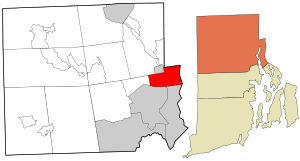
Location within Providence County and the state of Rhode Island
|
|||||
| Country | |||||
| State | |||||
| County | Providence | ||||
| Founded (town) | 1671 | ||||
| Incorporated (city) | 1886 | ||||
| Government | |||||
| • Type | Mayor-council | ||||
| Area | |||||
| • Total | 8.96 sq mi (23.22 km2) | ||||
| • Land | 8.67 sq mi (22.45 km2) | ||||
| • Water | 0.30 sq mi (0.77 km2) | ||||
| Elevation | 39 ft (12 m) | ||||
| Population
(2020)
|
|||||
| • Total | 75,604 | ||||
| • Density | 8,723.20/sq mi (3,367.98/km2) | ||||
| Time zone | UTC−5 | ||||
| • Summer (DST) | UTC−4 (Eastern) | ||||
| ZIP Codes |
02860–02861
|
||||
| Area code(s) | 401 | ||||
| FIPS code | 44-54640 | ||||
| GNIS feature ID | 1218926 | ||||
Pawtucket (pronounced pə-TUK-it) is a city in Providence County, Rhode Island, United States. In 2020, about 75,604 people lived there, making it the fourth-largest city in Rhode Island. Pawtucket is located near other cities like Providence and East Providence to the south. It also shares borders with towns in Massachusetts.
Pawtucket was a very important place for making textiles (cloth and fabric) early in history. It is home to Slater Mill, a famous textile mill known for helping to start the Industrial Revolution in the United States.
Contents
History of Pawtucket
The name "Pawtucket" comes from an Algonquian word meaning "river fall." This refers to the waterfalls in the area.
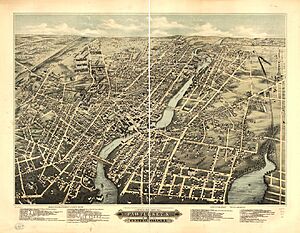
Before European settlers arrived, the Pawtucket area was one of the most populated places in New England. Native Americans would gather fish like salmon at the falls. The first European settler was Joseph Jenckes Jr., who arrived in 1671. He bought land near Pawtucket Falls and built a sawmill and a forge (a place to work with metal). Sadly, the entire town was destroyed during King Philip's War.
More settlers came after Joseph Jenckes. By 1775, the area was making things like muskets, oil from flax seeds, and ships. Around this time, Oziel Wilkinson and his family also started an iron forge. They made anchors, nails, farm tools, and cannons.
By the 1920s, Pawtucket was a busy and successful mill town. It had many movie theaters, hotels, and beautiful buildings. One of the most impressive buildings was the Leroy Theatre, a fancy movie palace. Many rich mill owners, like Darius Goff, built large homes in the area.
In 1922, the city's mills were affected by a large textile strike. Workers stopped working because their wages were cut and their hours were increased.
During the Great Depression, the textile business in New England faced hard times. Many factories closed or moved to the South, where it was cheaper to operate. Later in the 20th century, some of Pawtucket's old buildings, including the Leroy Theatre, were torn down.
However, Pawtucket kept much of its industrial work. Today, the city still produces things like lace, special fabrics, jewelry, silverware, and metal goods. Hasbro, one of the world's biggest toy and game companies, has its main office in Pawtucket.
How Pawtucket Became a City
The land that is now Pawtucket was once split between two different areas. The part west of the Blackstone River was part of North Providence. The part east of the river was originally part of Rehoboth, Massachusetts.
In 1828, Rehoboth gave up its land, and this eastern part became a new town in Massachusetts called Pawtucket. Then, in 1862, this eastern part became part of Providence County, Rhode Island. This change settled a very long border disagreement between Rhode Island and Massachusetts that had lasted for 225 years!
Later, in 1874, the land west of the river was taken from North Providence and added to the town of Pawtucket. For a while, it was like two separate towns. Finally, in 1886, West and East Pawtucket joined together and officially became one city.
Geography
Pawtucket covers about 8.7 square miles (22.45 square kilometers) of land and 0.3 square miles (0.77 square kilometers) of water. The city is located near three important rivers: the Blackstone River (which includes the Seekonk River), the Moshassuck River, and the Ten Mile River.
People of Pawtucket
| Historical population | |||
|---|---|---|---|
| Census | Pop. | %± | |
| 1830 | 1,459 | — | |
| 1840 | 2,184 | 49.7% | |
| 1850 | 3,753 | 71.8% | |
| 1860 | 4,200 | 11.9% | |
| 1870 | 6,619 | 57.6% | |
| 1880 | 19,030 | 187.5% | |
| 1890 | 27,633 | 45.2% | |
| 1900 | 39,231 | 42.0% | |
| 1910 | 51,622 | 31.6% | |
| 1920 | 64,248 | 24.5% | |
| 1930 | 77,149 | 20.1% | |
| 1940 | 75,797 | −1.8% | |
| 1950 | 81,436 | 7.4% | |
| 1960 | 81,001 | −0.5% | |
| 1970 | 76,984 | −5.0% | |
| 1980 | 71,204 | −7.5% | |
| 1990 | 72,644 | 2.0% | |
| 2000 | 72,958 | 0.4% | |
| 2010 | 71,148 | −2.5% | |
| 2020 | 75,604 | 6.3% | |
| U.S. Decennial Census | |||
Population in 2020
The 2020 United States census counted 75,604 people living in Pawtucket. The city is home to a diverse population. About half of the residents are white, and there are also many people who identify as Black or African-American, Native American, Asian, or Pacific Islander. A significant number of residents are of Hispanic or Latino background.
Many households in Pawtucket have children under 18. The average household has about 2.6 people. The median age in the city was 37.7 years old.
Pawtucket has a notable population of people from the former Portuguese Empire, including a large Cape Verdean community. It is also one of the few places in the United States with a significant population from Liberia.
Economy and Jobs
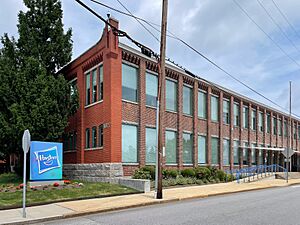
Hasbro, a major company that makes toys and games, has its main office in Pawtucket.
Many other businesses, including healthcare, retail stores, and insurance companies, also have their headquarters in the city. Fox Point Pickles, a company that makes pickles, is also based in Pawtucket.
Arts and Culture
Pawtucket has supported the arts since 1975. On September 2, 1977, the Beach Boys performed a concert at Narragansett Park. About 40,000 people attended, making it the largest concert audience in Rhode Island's history. In 2017, the street where the stage stood was officially renamed "Beach Boys Way."
Since 1999, Pawtucket has focused on becoming a center for arts and culture. The city created an Arts District to support artists and creative businesses.
Several experimental and indie rock bands have recorded albums at Machines with Magnets, a recording studio and art gallery in Downtown Pawtucket. Bands like Battles and Lightning Bolt have worked there.
Lorraine Mills is another important place for arts and culture. This old mill building now houses places like Mixed Magic Theatre, a comedy club called Wage House, and the Pawtucket Arts Collaborative.
Every September, the city hosts an annual Arts Festival. Pawtucket has also held an annual Saint Patrick's Day parade since 1982.
Sports in Pawtucket
For many years, Pawtucket was home to McCoy Stadium. The Pawtucket Red Sox, a professional baseball team linked to the Boston Red Sox, played there from 1970 to 2020. The longest professional baseball game ever, which lasted 33 innings, was played at McCoy Stadium in 1981. The Pawtucket Red Sox team moved to Worcester, Massachusetts, in 2021. McCoy Stadium was taken down starting in 2025.
In 2024, Rhode Island FC, a professional soccer team, began its first season. Starting in 2025, the team will play in a new stadium built specifically for soccer along the Seekonk River. The team's main office is in Pawtucket.
From 1934 to 1978, Narragansett Park was a famous place for horse racing. Top horses from across the United States, including famous ones like Seabiscuit and War Admiral, raced there.
Parks and Recreation
- Slater Memorial Park is a large park with tennis courts and picnic areas.
- Daggett Farm
- Water Color Gallery
- Daggett House
- Marconi Garden
Government
Pawtucket is led by a Mayor and a City Council. The current Mayor is Donald Grebien.
Education
Public Schools
The Pawtucket School Department manages the public schools in the city.
High Schools
- Charles E. Shea High School
- William E. Tolman High School
- Blackstone Academy Charter School
- Jacqueline M Walsh School for the Arts
Middle Schools
- Joseph Jenks Middle School
- Samuel Slater Middle School
- Lyman B. Goff Middle School
Elementary Schools
- Elizabeth Baldwin Elementary
- M. Virginia Cunningham Elementary
- Flora S. Curtis Elementary
- Curvin McCabe Elementary
- Fallon Memorial Elementary
- Nathanael Greene Elementary
- Agnes E. Little Elementary
- Potter Burns Elementary
- Francis J. Varieur Elementary
- Henry J. Winters Elementary
Catholic Schools
St. Raphael Academy is a private Catholic high school located in the Quality Hill area of Pawtucket. It is a college preparatory school with about 500 students. The school's sports teams are very successful. St. Raphael Academy used to have a long-standing football rivalry with William E. Tolman High School.
Pawtucket also has three Catholic elementary schools: St. Cecilia School, St. Teresa School, and Woodlawn Catholic Regional School.
Transportation
Pawtucket has several local bus routes run by the RIPTA. The Pawtucket/Central Falls station for the MBTA Commuter Rail opened on January 23, 2023, making it easier for people to travel by train.
Interstate 95 and U.S. 1 pass through the western part of Pawtucket. Some parts of I-95 in the city have slow speed limits because the highway has sharp turns to avoid certain buildings.
Sister City
Pawtucket has a sister city relationship with Belper, a town in Derbyshire, England. This connection is special because Samuel Slater, who helped start the Industrial Revolution in Pawtucket, learned about textile machinery in Belper. Belper holds an annual festival to celebrate this sister city bond.
Images for kids
See also
 In Spanish: Pawtucket para niños
In Spanish: Pawtucket para niños







